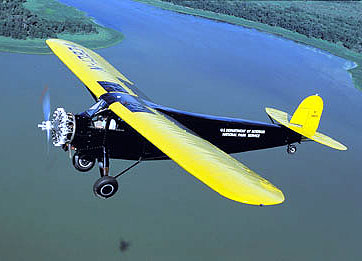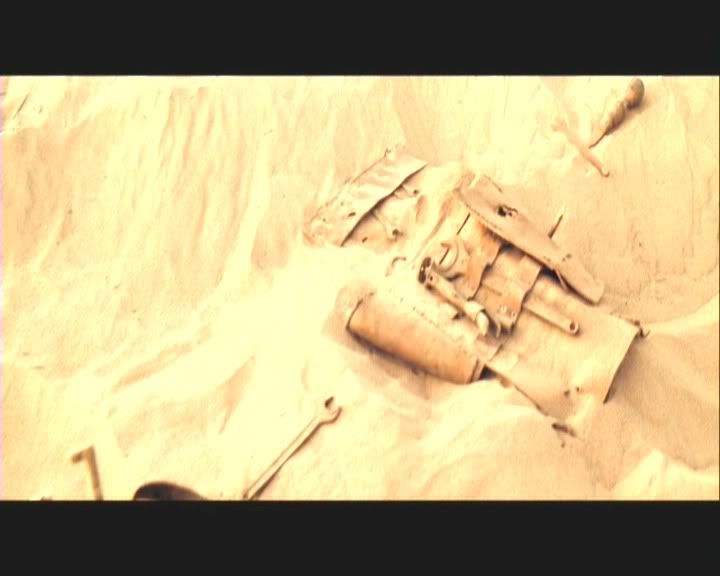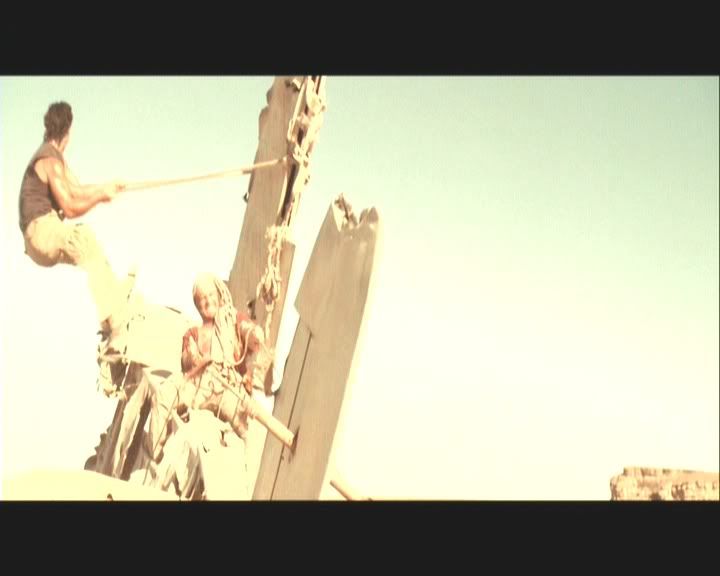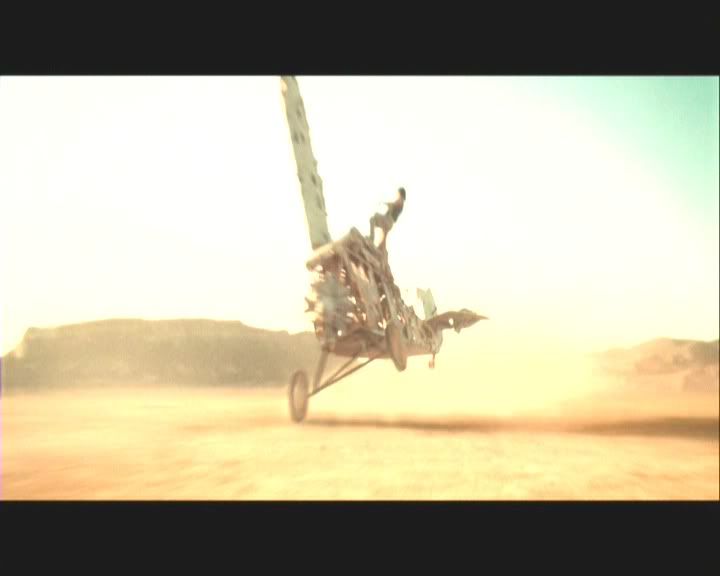|
|
Post by PK on Nov 16, 2012 17:00:53 GMT
Seeing as how I made mention elsewhere of the fact that there were some good PDT ideas over at Discovery, I figured I ought to post one that always intrigued me. It’s from the novel (and later movie) Sahara by Clive Cussler. I’m sure most are familiar with it, if not from the original source than from the old site, but I’ll lay it out anyway: 1931, an aviatrix flying solo across the Sahara desert experiences engine trouble and goes down. Initially she lands safely, but wrecks in a ravine. 1996, the heroes are escaping from the bad guys across the desert; first by car, then on foot. They come across the remains of the plane and using the small tool kit they find on board, manage to convert it into a makeshift land yacht which they use to make their way to the Trans-Sahara Highway and rescue. They use a section of wing as the sail, cabling as standing rigging, some rope that was (conveniently) on board for running rigging, etc. As I see it, the basic concept of building a rigid-wing land yacht is sound. They certainly exist and work. The only major design issue would be that it would have an asymmetrical wing/sail, and would only sail well on one tack. There are also a lot of practical issues: After 65 years in the desert, would the tires still be able to hold air? Would the wood frame of the plane be so dried and brittle that it would stand up to the extremes of sailing portrayed in the book? Would the lubricants in the landing gear have survived to keep the wheels rolling? Would the few tools available be enough to dismantle the original plane are rebuild the yacht? Would the men (who were ready to drop from exhaustion, dehydration and sun stroke when they found the plane) be recovered enough from simply sleeping to accomplish the task? As I see it, replicating the condition of the men would be too dangerous to test accurately. They could do it while exhausted, but not dehydrated and overheated. They certainly wouldn’t want to push anyone to such extremes for a myth. The condition of the plane would be difficult to replicate unless they found an appropriate plane at a site such as the desert storage yard they’ve used before. So the real testing would have to revolve around dismantling and rebuilding the plane with only two (tired) men and a basic tool kit. (and yes, I’m well aware of the hypocrisy involved here, being as I’ve always been in the “movies aren’t myths” camp. So no comments from the peanut gallery!  .) |
|
|
|
Post by Cybermortis on Nov 16, 2012 17:40:33 GMT
|
|
|
|
Post by PK on Nov 16, 2012 18:02:25 GMT
 OK, I guess that deserves a bit of exautation. I'm going to dig up the novel later today and see how the tool kit described there compares with the one you got the screen-shot of (I'm more a fan of the book than the movie anyway).
|
|
|
|
Post by Cybermortis on Nov 16, 2012 18:35:38 GMT
Looking again at the stills it does appear that this was built for real, and the lack of a dust trail in front of the yacht could indicate that it was moving under its own power rather than being towed. Of course that power might not have been coming from the wind but an engine.
|
|
|
|
Post by PK on Nov 16, 2012 18:40:09 GMT
I've always figured that if it COULD be built, it would work (at least to some extent). For me, the question always been about the building.
|
|
|
|
Post by Cybermortis on Nov 16, 2012 19:21:35 GMT
I don't think you can separate the two questions of 'could it be built?' and 'would it have worked?'.
I think there are a couple of interconnected questions they would need (and want) to look at.
1; Could you modify an aircraft similar to the one in the film to turn it into a land-yacht using only those tools either shown in the film or mentioned in the book? Or that you could reasonably expect to find on an aircraft of that date that was flying off to explore. Pilots of that time and in that situation could be assumed to have been prepared to deal with emergencies and may have been carrying more than just a basic tool kit.
2; Is the basic principle sound? That is would a land yacht built from an aircraft even work?
3; Would you be able to get the sort of high speed performance as seen in the film?
4; If you could modify an aircraft, could it be done before the hero's died from exposure?
Testing 2 could be done in small scale, which would give them an insight as to what would be needed to be done to a full-sized aircraft.
1 can be tested by getting (or building) an aircraft of similar construction and design, handing the team (in this case either Adam and Jamie or Tory and Grant as there were only people involved in the fictional build) those tools and materials that are seen or mentioned in the film or book and seeing what they can do. If they time them they can then make a reasonable call on if it could have been built before the guys died*. If they can't manage to build it in a day with what they have, then they could go back the next day and expand the tools they have to work with in order to finish building it - by that point they should have a fair idea as to what areas they'd need other tools for.
3 would naturally require that they take their finished yacht for a spin, or something like it. This would give them the 'wow' factor for the end test.
(*Observation/note; In the film it appears that they stumble over the aircraft, modify it and set off all in a day. However all we know is that it was daylight when they found the aircraft, and daylight when they were using it as a yacht. It is not unreasonable to assume that they found and worked on the aircraft on day one, possibly working into the night. But waited until the next morning before setting sail - which would be a logical decision to make since they could see where they were going and avoid hazards much more easily in daylight.
So we should probably allow 12-18 hours for the build. If it takes significantly longer than this we can assume that the hero's are either going to die from exposure or be in no condition to pilot the thing.
If they want to be really accurate about the difficulties they could try doing the build in the dessert...I can see Kari sitting under a sun-shade, glasses and hat on, sipping an ice cold drink while the guys are working. Then she turns her head and says 'I'd help you boys, but I'm not in this scene'.)
|
|
|
|
Post by The Urban Mythbuster on Nov 16, 2012 20:00:52 GMT
The only thing I wonder about is the material used for the sail. Would the metal from the wing be too heavy to accomplish stability? While land yachts appear to have rigid sails, I believe they are made from the same material used for the sails of racing yachts, which I believe is a very rigid (though not completely stiff) nylon (standard yacht sails are made from canvas).
Also, standard sails, while in use, billow and become concave in shape to allow wind to collect and propel the vessel. On the other hand, the wing is convex, which would divert the wind.
|
|
|
|
Post by PK on Nov 16, 2012 21:16:26 GMT
Most of them have soft sails, just as most sailboats do: a rigid mast, a rigid boom along the bottom and a triangular sail to fill in between them. The "wing" shape comes from the wind and it's symmetry depends on which tack the vessel is on (which side the wind is blowing from). Change tacks, and the symmetry changes to the other side.
However there have been a few land-yachts that have been build with rigid-wing "sails", very much along the lines of what the current Americas Cup boats use. They are, essentially, a symmetrical wing stood up on end. And they are built the same way that an airplane wing is built: a rigid framework wrapped in some kind of lightweight covering.
|
|
|
|
Post by PK on Nov 16, 2012 21:43:33 GMT
Going strictly by the novel, since I don't recall the details of the film: The plane used was a Fairchild FC-2W  The undercarriage collaped upon falling into the ravine (contrary to what the sailing scene in the movie depicts), but the wings and airframe remained intact (and to further my answer above, the frame work was of wood, not metal). Unfortunately, there's no description of the tools available other than "a small toolbox" and "a small hacksaw and a tire repair kit with hand pump". Obviously there's a limit to what would fit into such a toolbox, but it leaves it pretty open as to what they could have available. And from what I've read (although there is no mention of it in the book) the Fairchild had folding wings, which I'd think would make it easier to remove. The tires were too dried and cracked to hold air, so they filled them with sand. The cockpit was cut down and the wheels were extended outwards with the struts, which I'd guess would give it a much lower center of gravity than was depicted in the film. The book also specifies that they reached speeds of up to 60 kph Now how they'd measure that, I don't know, but I supposed that's the authors privledge. Then again, this is the same person who confuses "heeling" with "hiking": ".... suddenly there was daylight under the windward wheel. Higher it lifted in a condition known among land sailors as *hiking*." and then "he had to take corrective action to prevent the hike from capsizing the land yacht". Of course he is refering to heeling; hiking is the act of shifting your body weight to windward to correct the heel - what Pitt/McConawhatever is doing in Cybers photos. EDIT: One other detail I almost forgot: Once built, they had to haul it out of the ravine it was in. The shallowest slope they could find was 30°, and 7m high. |
|
|
|
Post by Cybermortis on Nov 16, 2012 22:24:05 GMT
en.wikipedia.org/wiki/Fairchild_FC-2The FC-2W version seems to have been originally designed as a cargo carrier, and if Wilki is to be believed took part in around the world flight in 1928 - which might be why this aircraft was used in the book. I can, in fact, accept that the cargo version would have been used for long distance flight as there would have been more room for supplies and additional fuel tanks (or bladders) inside the aircraft. Given the date (1931) and that this was a civilian aircraft I'd expect that the skin of the aircraft was fabric. I'm not aware of all metal aircraft entering production until 1931 (the Junkers Ju 52 is the first I can think of, in 1931). I can't confirm this, but it fits with what I know of aviation history, aircraft design and the difference between civilian and military aircraft - The Junkers Ju 52 was probably built with an eye towards military use (as the Ju 88 was), although it wasn't used by the Luftwaffe until 1934/5.
|
|
|
|
Post by PK on Nov 16, 2012 22:31:20 GMT
In the book he specifies that "the four-passenger aircraft had once been owned by Pan Am and flew scheduled mail stops", and that after she purchased it Kitty (the flier) had installed extra gas tanks in the passenger compartment for her goal of setting long-distance flying records.
|
|
|
|
Post by silverdragon on Nov 17, 2012 9:50:15 GMT
Desert, Dunes, Sand----
I have "played" with a Paris-Dakar vehicle, the suspension its self is pretty amazing.
I dont think you would have "enough" left of that vehicle to replicate a suspension setup that would make the trip?....
|
|
|
|
Post by the light works on Nov 23, 2012 4:33:47 GMT
nitpick: with a multihull sailing craft, the term used is "flying a hull" once a hull leaves the water. not sure if that translates to "flying a wheel" on a landyacht or not.
|
|
|
|
Post by blazerrose on Nov 28, 2012 8:34:08 GMT
I remember an episode of Man vs. Wild where he built a land boat using a parachute, but not from parts of a plane. The chute took off with him and was rather difficult to control, IIRC.
|
|
|
|
Post by Cybermortis on Nov 28, 2012 14:22:31 GMT
One small problem I can foresee with MB deciding to test this is control - by which I mean the factors they need to control to run tests.
In this case testing the design in full scale rests on the wind, which is unpredictable, and they could well end up wasting several days waiting for a suitable breeze to spring up so they can start testing.
Can anyone think of a way they might be able to get around this for the full-sized testing? If the hope is to have the full-sized yacht sailing along at speed they could not run these tests indoors.
|
|
|
|
Post by the light works on Nov 28, 2012 15:41:43 GMT
weatherguessers are much better than they used to be - and winds tend to be consistent day-to-day. if my hometown can run a condition dependent surfing competition on 24 hours notice, they can probably store their end product near an appropriate venue and get there in the afternoon, after getting confirmation of conditions in the morning.
|
|
|
|
Post by Cybermortis on Nov 28, 2012 15:57:25 GMT
They have a shooting schedule that prevents them from dropping everything to run off to test something else. The boards we've caught glimpses of indicate that they set aside x-number of days to do all the work and filming and some of those days are set aside for location filming. Educated guess is that they'd only have three days open for location filming.
Also remember that we are not talking about the cast hopping into a car and driving off. They have to transport all of the camera equipment and crew to the location, as well as other support staff. This is not something that they can do on the spur of the moment.
|
|
|
|
Post by PK on Nov 28, 2012 16:17:23 GMT
Obviously it's not a sure thing, but there are places where the wind can be pretty predictable at certain times of the year.
The winds on SF Bay are a good example. I don't see any reason they'd need to go to an actual desert to test this (as in the book/movie). One of the runways at ANAS would serve just fine, and I can tell you from experience that that area gets quite a bit of wind (I grew up sailing in the estuary, watching jets take off from the runways right along side).
I don't know what the overall status of Treasure Island is (where they've been filming more and more myths), but it's located right in "the slot", which is a Bay sailors dream. Glancing at Google Maps, I see that there are a couple of wide roadways running perpendicular to the wind.
|
|
|
|
Post by the light works on Nov 28, 2012 16:31:39 GMT
They have a shooting schedule that prevents them from dropping everything to run off to test something else. The boards we've caught glimpses of indicate that they set aside x-number of days to do all the work and filming and some of those days are set aside for location filming. Educated guess is that they'd only have three days open for location filming. Also remember that we are not talking about the cast hopping into a car and driving off. They have to transport all of the camera equipment and crew to the location, as well as other support staff. This is not something that they can do on the spur of the moment. can't be that much harder than getting surfers, judges, sponsors, and camera crews together on short notice. |
|
|
|
Post by Cybermortis on Nov 28, 2012 16:34:20 GMT
The problem is that they would still be gambling on the conditions being suitable on the day or days they have available for testing - if they are not then they end up with nothing to air. (This, BTW, is probably why they haven't tested the 'downwind faster than the wind' myth). Producers are under a lot of pressure to produce X number of episodes per year/season, and they can't afford to loose 7-10 days of filming. Thus they are going to be very wary of going forward with ideas that depend on factors beyond their control such as the weather. What is needed is a backup plan, a way they could test this (and similar) ideas out without having to rely on the wind. They have a shooting schedule that prevents them from dropping everything to run off to test something else. The boards we've caught glimpses of indicate that they set aside x-number of days to do all the work and filming and some of those days are set aside for location filming. Educated guess is that they'd only have three days open for location filming. Also remember that we are not talking about the cast hopping into a car and driving off. They have to transport all of the camera equipment and crew to the location, as well as other support staff. This is not something that they can do on the spur of the moment. can't be that much harder than getting surfers, judges, sponsors, and camera crews together on short notice. Yes it is. Adam has noted that on several occasions they've had to scrap testing for the day, not because they were not ready but because they waited so long for the film crews to set up it became too dark to film. Filming for a TV show is a FAR more complex process than grabbing a camcorder, as the quality of the film and sound has to be higher for TV. In the case of MB they also have to set cameras up to cover all the angles because they probably won't get a second chance to get footage. There are also legal issues, in how long the crew can work, what conditions they are allowed to work under and what support structures need to be in place - such as food trucks and medical aid. Even their smallest and simplest location shoots involve two or three trucks - one of which is purely for the camera equipment - plus catering. Then you have several cars and trucks to transport the cast and crew. |
|
 .)
.) .)
.)











